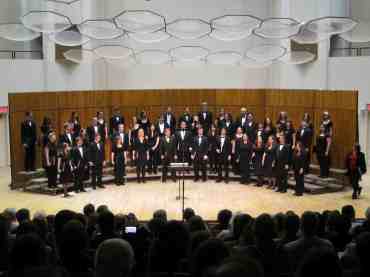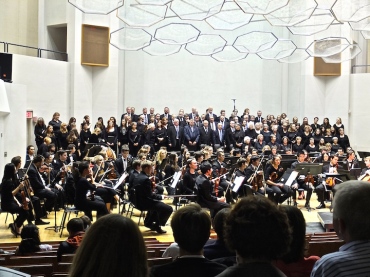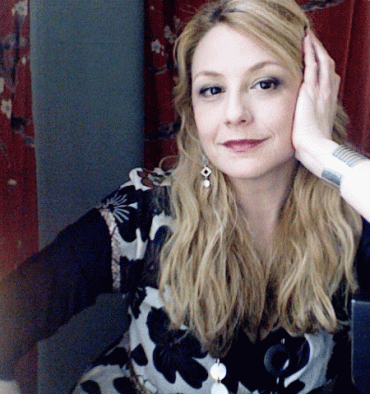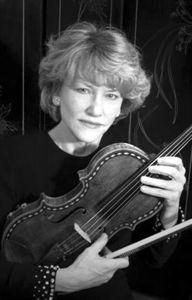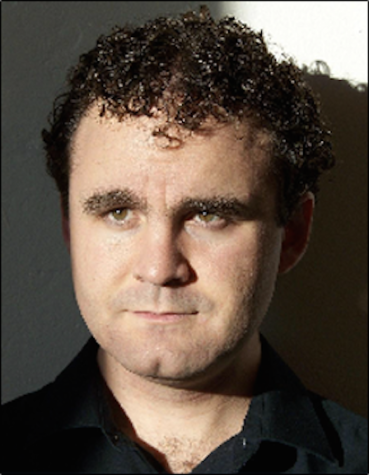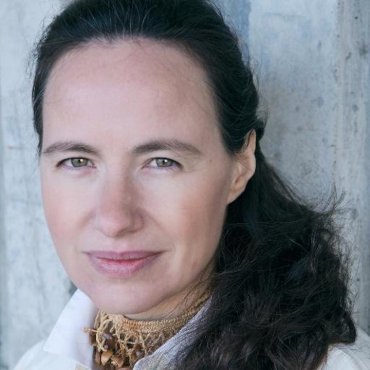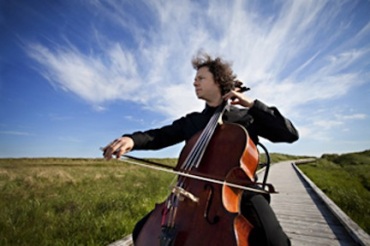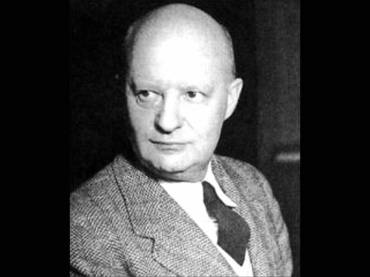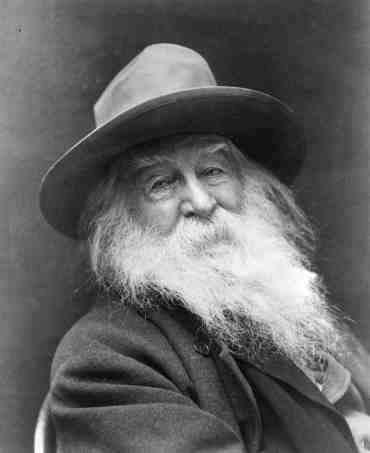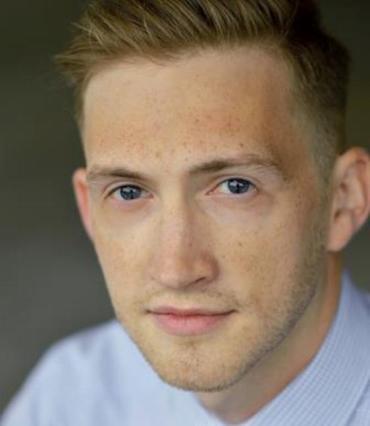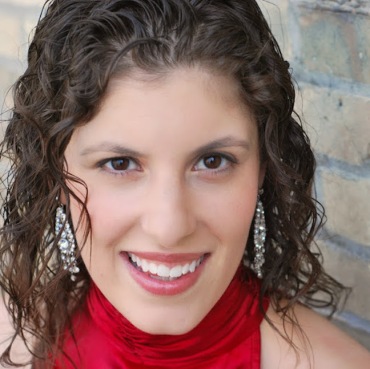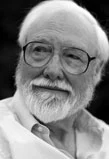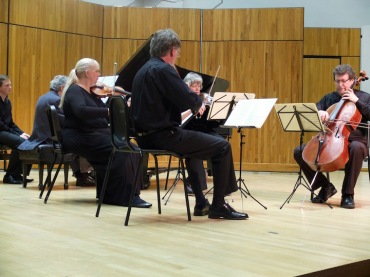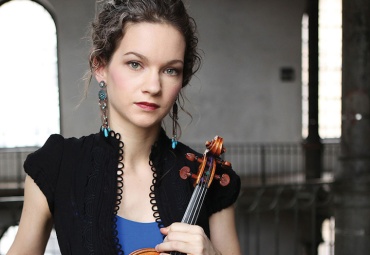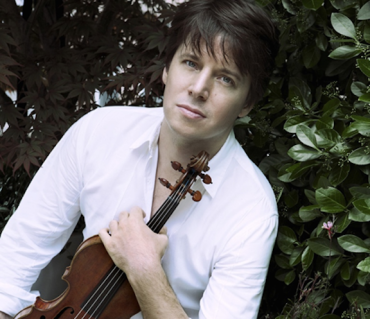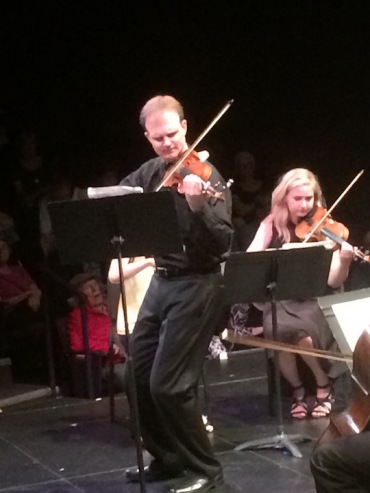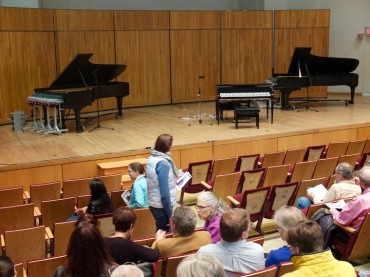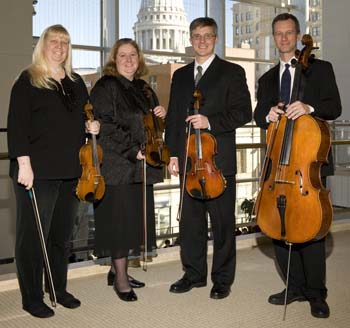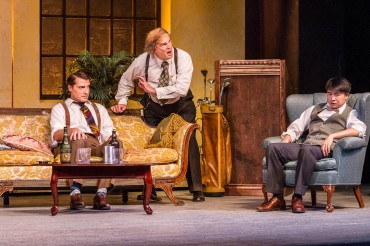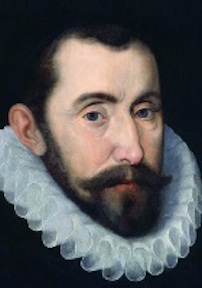The Well-Tempered Ear
Classical music: The UW Concert Choir, Choral Union and Symphony Orchestra will perform world premieres, local premieres and new music in three concerts this weekend
1 Comment
By Jacob Stockinger
The Ear has received the following messages from UW composer Laura Schwendinger and from Beverly Taylor, the director of choral activities at the University of Wisconsin-Madison School of Music who is also the assistant conductor and chorus director of the Madison Symphony Orchestra:
Writes conductor Beverly Taylor: This is a busy and musically fascinating weekend for me coming up.
On Friday night at 8 p.m. in Mills Hall, there is a special concert by the Concert Choir (below) on the subject of Art Born of Tragedy, with the acclaimed guest cellist Matt Haimovitz.
Tickets are $15, $5 for students. For more information about tickets as well as the performers and the program, go to:
http://www.music.wisc.edu/event/uw-concert-choir-4-matt-haimovitz/
Then in Mills Hall at 8 p.m. on Saturday night and at 7:30 p.m. on Sunday night, there are two performances of When Lilacs Last in the Dooryard Bloomed by the 20th-century composer Paul Hindemith by the UW Choral Union and the UW Symphony Orchestra (below). It is a work that to my knowledge has never been performed in Madison.
Tickets are $15, $8 for students. For more information about obtaining tickets and about the concert, visit:
http://www.music.wisc.edu/event/uw-choral-union-uw-symphony-orchestra/
Here is more information about the events:
CONCERT CHOIR
The Concert Choir performance explores in music of several centuries the theme of “Art Born of Tragedy” — how outside events can be the spark that causes the creation of works of substance that range from the gentle and comforting to rage and despair.
We will sing music from the Renaissance: part of the Thomas Tallis’ “Lamentations of Jeremiah (on the ancient destruction of Jerusalem),” and a John Wilbye madrigal “Draw on Sweet Night for a Broken Heart.”
We will present three works from modern composers: one is a world premiere by the prize-winning composer Laura Schwendinger (below top), my colleague at the UW-Madison, for viola — played by Sally Chisholm (below bottom) of the UW Pro Arte Quartet — and wordless chorus. It is called “For Paris” in memory of those killed in the Paris terrorist bombings of 2015.
(Adds composer Laura Schwendinger: “The viola starts this short work by referencing only for a moment the merest idea of a ‘musette song,’ one that might be heard on an evening in a Paris cafe. The choir enters with a simple refrain that repeats again and again, each time with a little more material, as an unanswered question of sorts. Each time the viola reenters the texture, the music becomes more pressing in a poignant manner, until it arrives in its highest register, only to resolve with the choir as it quietly acquiesces in the knowledge that the answer may not be known.”)
We will present a short “O vos omnes” (O you who pass by) written by Pennsylvania composer Joseph Gregorio (below), composed in memory of a Chinese girl hit by a car and left to die.
The third piece is a reprise of “Après moi, le deluge” by Luna Pearl Woolf (below top), which we premiered and recorded 11 years ago. We are lucky to have back the wonderful internationally known cellist Matt Haimovitz (below bottom), who premiered this work with it. The text, written by poet Eleanor Wilner, mixes the Noah story with the Hurricane Katrina disaster.
The term “Après moi, le deluge” is a term attributed to Louis XV or his mistress Madame Pompadour, and means “after me the flood” — referring either to the chaos after his reign, or that what happens afterword bears no importance for him.
The work has four different moods like a symphony — with strong themes at the start and cries for help, followed by the slow movement despair, a scherzo-like depiction of havoc, and a final movement that is like a New Orleans funeral, upbeat and Dixieland.
Throughout the program we also present spirituals that depict loneliness or salvation from trouble.
UW CHORAL UNION
In certain ways, When Lilacs Last in the Dooryard Bloomed resembles the Concert Choir concert in that it contains a number of moods and styles as well, under a dark title. The subtitle of the work is “a Requiem for Those We Love.”
It was commissioned by the great choral and orchestral conductor Robert Shaw as a tribute to President Franklin Delano Roosevelt on his death and the train ride that carried him from Warm Springs, Georgia, to Washington, D.C.
The text that Paul Hindemith (below top) chose is by Walt Whitman (below bottom), who wrote his poem on the death of Abraham Lincoln, and the funeral train from Washington, D.C., to Springfield, Illinois.
Whitman’s grief is combined with pride and joy in the countryside that the train traverses, and his feelings find an outlet in the thrush that sings out its song. His sense of a sustaining universe is a contrast to his depiction of the despair and ravages of the Civil War.
Hindemith’s calling the work a “Requiem for Those We Love,” puts it, like the Brahms’ “German” Requiem, into a class of non-liturgical requiems — that is, the texts are not those that are part of the Catholic Mass for the Dead, but are other selected texts of joy or remembrance.
Hindemith’s style can loosely be described as tonal that veers away into dissonance and returns again to the home key. The Prelude and opening movement are dark; the solo songs of baritone (James Held, below top) and mezzo-soprano (Jennifer D’Agostino, below bottom) are marvelous; the fugue on the glories of America is glorious and other sections are soft and tender. (NOTE: You can hear the orchestral prelude of the work, with composer Paul Hindemith conducting the New York Philharmonic, in the YouTube video at the bottom.)
The work is hard for both chorus and orchestra, but well worth the effort. The piece is about 80 minutes long and will be performed without interruption. It’s a work I’ve always wanted to do, having heard it performed at Tanglewood many years ago. I’m delighted to have the chance now.
Tags: 20th-century, Art, Arts, auto, baritone, Beverly Taylor, born, cafe, car, Catholic, Chamber music, chaos, China, Chinese, Choir, choral music, Choral Union, chorus, Civil War, Classical music, comfort, composer, Concert Choir, conductor, D.C., dead, despair, dissonance, Dixieland, Early music, Eleanor Wilner, FDR, Franklin Delano Roosevelt, fugue, funeral, gentle, Georgia, grief, heart, Hurricane, Hurricane Katrina, ILLINOIS, Jacob Stockinger, James Held, Jennifer D'Agostino, Jeremiah, Jerusalem, John Wilbye, Joseph Gregorio, Joy, Kartrina, lamentation, Laura Schwendinger, Lincoln, liturgical, liturgical music, Louis XV, Love, Madame Pompadour, Madison, Madison Symphony Orchestra, madrigal, mass, Matt Haimovitz, Mezzo-soprano, musette, Music, New Music, New Orleans, New York Philharmonic, Orchestra, Paris, Paul Hindemith, Pennsylvania, poet, Prelude, premiere, President, Pro Arte Quartet, rage, ravages, reign, remembrance, Renaissance, Requiem, Requiem Mass, Robert Shaw, Scherzo, song, Springfield, symphony, symphony orchestra, Tanglewood, Tanglewood Festival, terror, terrorist, Thomas Tallis, tonal, tragedy, train, United States, universe, University of Wisconsin-Madison School of Music, University of Wisconsin–Madison, UW, Viola, Violin, vocal music, Walt Whitman, Warm Springs, Washington, When Lilacs Last in the Dooryard Bloomed, Wisconsin, world premiere, YouTube
Classical music: Here are memorable local concerts in 2016 from critic John W. Barker and The Ear. What ones would you add?
1 Comment
ALERT: The FREE Friday Noon Musicales at the First Unitarian Society of Madison, 900 University Bay Drive, resume this week after a break for Christmas, New Year’s and other holidays. This Friday, from 12:15 to 1 p.m., pianist Olivia Musat will perform music by Olivier Messiaen, Isaac Albeniz and Paul Constantinesco.
By Jacob Stockinger
It seems a tradition throughout the media to offer a roundup of the Year’s Best with a local slant.
The Ear already offered a national and international roundup. Here is a link to that, especially to the surprisingly rich roundup that he unexpectedly found on Wikipedia:
For a more local perspective, The Ear trusts and generally agrees with critic John W. Barker (below), who writes frequently for this blog and more often for Isthmus.
Here is a link to Barker’s list of memorable concerts in the Madison area, Because Isthmus mixes classical with other genres like pop, folk and jazz, you have to scroll down to “Classical cornucopia”:
http://isthmus.com/music/year-in-music-2016/
Although I agree with all the concerts that Barker mentions, he left out some that The Ear really loved. One was the absolutely riveting and moving performance in November by the Madison Symphony Orchestra under John DeMain of the momentous Fifth Symphony by Dmitri Shostakovich.
For example just about everything that the Pro Arte Quartet does at the University of Wisconsin-Madison School of Music is first-rate and memorable, whether they play in Mills Hall or on “Sunday Afternoon Live From the Chazen Museum of Art.”
But this past fall, a free noontime concert by the Pro Arte with legendary pianist Leon Fleisher especially stood out. Together (below), they performed the Piano Quintet in F Minor by Johannes Brahms – an unquestionable masterpiece in an unforgettable performance.
The Ear would also add two events, both violin recitals, at the Wisconsin Union Theater.
Last spring Hilary Hahn (below top, in a photo by Peter Miller) turned in a stunningly superb recital. Then this fall, superstar Joshua Bell (below bottom) did the same. Both artists displayed terrific musicality combined with terrific virtuosity in generous and first-rate, ambitious programs.
He would add several summer concerts by the Bach Dancing and Dynamite Society, especially the sizzling dueling violin concert (below) where the BDDS interspersed “The Four Seasons” buy Antonio Vivaldi with “The Four Seasons in Buenos Aires” by Astor Piazzolla.
The Ear would also add an experimental concert at which UW-Madison pianist Christopher Taylor (below) unveiled his reworked two-keyboard “Hyperpiano.” While the concert, which featured the “Goldberg” Variations by Johann Sebastian Bach, wasn’t successful musically, it certainly was intriguing, unusual and highly memorable, even with imperfect digital technology.
And The Ear also recalls a fine concert by the Rhapsodie Quartet (below) of the Madison Symphony Orchestra at the Overture Center.
And let’s not forget the University Opera’s production of “Falstaff” by Giuseppe Verdi that was impressively and successfully updated to Hollywood by director David Ronis.
The Ear is sure there are more memorable concerts that escape him right now. Madison just features so much wonderful music-making in the course of a year.
Moreover, The Ear is also sure you have your favorites – whether they are individual plays; small chamber music groups such as duos, string quartets and piano trios; larger ensembles like the Madison Symphony Orchestra and the Wisconsin Union Theater; or entire events like the UW Brass Festival.
I am sure that fans of the innovative percussion group Clocks in Motion and the acclaimed Madison Choral Project have a concert or two to nominate.
So please use the COMMENT section to tell us what were your most memorable classical concerts in Madison during 2016.
The Ear wants to hear.
Tags: "Goldberg" Variations, Albeniz, Arts, Ástor Piazzolla, Bach, Bach Dancing and Dynamite Society, Baroque, BDDS, brass, Brass Festival, Cello, Chamber music, Chazen Museum of Art, choral music, Christmas, Christopher Taylor, Classical music, Clocks in Motion, concerto, David Ronis, digital, duets, duo, Early music, Falstaff, First Unitarian Society of Madison, folk, Four Seasons, Four Seasons of Buenos Aires, Franz Schubert, Hilary Hahn, Holiday, Hollywood, Hyperpiano, Isthmus, Jacob Stockinger, Jazz, Johann Sebastian Bach, Johannes Brahms, John DeMain, John Wilbye, Joshua Bell, Ludwig van Beethoven, Madison, Madison Choral Project, Madison Opera, Madison Symphony Orchestra, Messiaen, Mozart, Music, New Year, New Year's, opera, Orchestra, Overture Center, Paul Constantinesco, percussion, Piano, pop, Pro Arte Quartet, Quartet, quintet, Shakespeare, Shostakovich, Sonata, String quartet, Sunday Afternoon Live From the Chazen, symphony, technology, trio, United States, University of Wisconsin-Madison School of Music, University of Wisconsin–Madison, University Opera, Verdi, Viola, Violin, Vivaldi, vocal music, Wisconsin, Wisconsin Chamber Orchestra, Wisconsin Union Theater, Wolfgang Amadeus Mozart
Classical music: The wind quintet Black Marigold announces its four upcoming FREE winter concerts. Plus there is a FREE concert of wind music this Friday at noon.
1 Comment
ALERT: This week’s FREE Friday Noon Musicale, held from 12:15 to 1 p.m. at the First Unitarian Society of Madison, 900 University Bay Drive, features bassoonists Rozan Anderson and Willy Walter with oboist Scott Ellington and English hornist Ruth Dahlke in music by Bela Bartok, Bill Malcolm, Ange Flegier, Sarah Woolsey, Thomas Morley and John Wilbye with a world premiere by Louise Hillery.
By Jacob Stockinger
The Ear has received word from the Madison-based wind quintet Black Marigold about its upcoming winter concerts running from January 23 through January 31.
Members of Black Marigold (below) include Elizabeth Marshall, flute; Laura Medisky, oboe; Bethany Schultz, clarinet; Kia Karlen, horn; and Carl Wilder, bassoon.
Here is the announcement:
“Add a dash of heat to your winter with a hearty dose of chamber music!
“Black Marigold’s winter program features: the Wind Quintet in C major, Op.79 (ca. 1898, heard at bottom in a YouTube video) by August Klughardt; “La Cheminée du Roi René,” Op. 205 (1939) by Darius Milhaud; and two contemporary pieces by Brian DuFord: Vignettes Balletiques (2011) and Variations on an Afro-Cuban Lullaby (2012).
“You can learn more about Black Marigold’s 2016 commissioning collaboration with Brian DuFord (below), a musical salute to Wisconsin craft brews and beer, at http://www.blackmarigold.com/beermusic.html
“All concerts are FREE and OPEN TO THE PUBLIC.
Here is a complete schedule:
“Saturday, January 23, 2016 – 7 p.m. Orchard Ridge United Church of Christ 1501 Gilbert Rd, Madison
“Sunday, January 24, 2016 – 2 p.m. First United Methodist Church 203 Wisconsin Ave, Madison
“Friday, January 29, 2016 – 12:15 p.m. First Unitarian Society, Noon Musicale Series, 900 University Bay Drive, Madison
“Sunday, January 31, 2016 – 4 p.m. St. Peter’s Episcopal Church, Chamber Series, Fort Atkinson, Wisconsin
“Black Marigold is a dynamic wind quintet that has performed throughout Wisconsin since 2012.
“As advocates of new music and living composers, the quintet presents captivating concerts introducing new music, while also highlighting classic woodwind quintet repertoire.
“For more information, visit:
https://www.facebook.com/BlackMarigold/
Tags: African, Afro-Cuban, Arts, August Klughardt, Bartok, Bassoon, Beer, Black Marigold, Brian DuFord, Chamber music, clarinet, Classical music, craft brews, Cuba, Cuban, Darius Milhaud, English horn, First Unitarian Society of Madison, flute, Horn, Jacob Stockinger, John Wilbye, Louise Hillery, Madison, Milhaud, Music, New Music, Oboe, Orchestra, quintet, Thomas Morley, United Methodist Church, United States, University of Wisconsin-Madison School of Music, University of Wisconsin–Madison, Wind quintet, winds, winter, world premiere, YouTube
Classical music: Early music group Eliza’s Toyes offers a fascinating exploration of the role of music in medicine from Medieval though Baroque times.
Leave a Comment
By Jacob Stockinger
Here is a special posting, a review written by frequent guest critic and writer for this blog, John W. Barker, who also took the performance photos. Barker (below) is an emeritus professor of Medieval history at the University of Wisconsin-Madison. He also is a well-known classical music critic who writes for Isthmus and the American Record Guide, and who for 12 years hosted an early music show every other Sunday morning on WORT FM 89.9 FM. He serves on the Board of Advisors for the Madison Early Music Festival and frequently gives pre-concert lectures in Madison.
By John W. Barker
Eliza’s Toyes (below top), the consort of voices and instruments devoted to early music, is led by the formidably talented Jerry Hui. The group gave another of its imaginative programs, this time on Friday night at the Wisconsin Institutes for Discovery (below bottom).
The theme and title of this program was “Music: The Miracle Medicine.” Offered were 15 selections, conveying various ideas or beliefs about health (both physical and spiritual), illness, medicine, miracle cures and good living.
Each selection was preceded by the reading of passages from moral and medical texts of various periods. (I wonder if today’s medical and health-advice writings will sound as comical generations from now as do those of the past to us!)
Fifteen composers were represented in the course of the program, from Medieval through Baroque: Hildegard von Bingen (below top, 1098-1179), Alfonso El Sabio (1221-1284), Thomas Tallis (1505-1585), Cipriano da Rore (1516-1565),Hubert Waelrant (1515-1595), Orlando di Lassus (1532-1594), William Byrd (1540-1623), Lelio Bertani (1553-1612), John Wilbye (1574-1638), Gabriel Bataille (1575-1630), Melchior Franck (1579-1639), John Maynard (15??-16??), Anonymous 17th-Century (2 items), Marin Marais (1656-1728) and John Eccles (1668-1735).
The selections were mostly vocal, either solo or ensemble. One instrumental selection stood out as probably the one most likely to be familiar: Marin Marais’ excruciatingly detailed “Representation of the Operation for Gallstone” (below top is Marais, below bottom is the introduction to his work) — complete with narrative headings for each section. (You can hear the narration and the music to the unusual piece in a YouTube video at the bottom.)
The performances were earnest and often accomplished. But it must be said in honesty that, in motets and madrigals, the vocal ensemble was not balanced or smooth — the singers clearly need to live with this kind of musical writing somewhat longer. Still, the overall effect was certainly entertaining and thematically fascinating.
There were no printed programs, but the titles and text translations were projected on a background screen. These projections were fully visible and readable, so they worked well.
This is a program that will be offered again, I understand, at the Chazen Museum of Art on July 15, so that it can be caught and savored once more.
Above all, it is one more tribute to the thoughtful, deeply researched and intriguing program skills of Jerry Hui (below).
Tags: Arts, Baroque, Cello, Chamber music, Chazen Museum of Art, choral music, Classical music, cure, Early music, gallstones, good living, Health, Hildegard von Bingen, illness, instrumental music, Jacob Stockinger, Jerry Hui, John W. Barker, John Wilbye, living, Madison, madrigal, Marin Marais, medicine, Medieval, Melchior Franck, miracles, motet, Music, music therapy, Orlando de Lassus, Orlando di Lasso, projections, screen, text, Thomas Tallis, United States, University of Wisconsin-Madison School of Music, University of Wisconsin–Madison, viola da gamba, vocal music, wellness, William Byrd, Wisconsin, Wisconsin Institutes for Discovery, WORT-FM 89.9, YouTube
Classical music: The early music group Eliza’s Toyes will explore music as medicine in a concert this Friday night at the Wisconsin Institutes for Discovery.
Leave a Comment
By Jacob Stockinger
The Ear’s friend Jerry Hui –- a supremely talented individual and graduate of the University of Wisconsin-Madison School of Music who performs, composes and teaches at UW-Stout – sends the following word:
The Madison-based early music group Eliza’s Toyes (below top) has a concert this Friday night, May 22, at 7:30 p.m. at the Wisconsin Institutes for Discovery (below bottom). The concert is titled “Music: The Miracle Medicine.”
Here is an introduction to the program:
“Rediscover the integral role of music as the restorer of health in the early days of medical science during the Medieval, Renaissance and Baroque periods.
“Music has been an integral part of our wellbeing. To this date, many listen to music for its power in relaxation, excitement, and even catharsis. The development of music therapy as a medical profession, as well as increasing research in the physiological and psychological effects of music, signifies our ongoing interest to understand and utilize music.
“As scientists continue to examine music in a utilitarian light, it is worthwhile for us to rediscover how human beings have historically viewed music and its connection with health.”
Tickets will be available at the door: $15 for the general public and $10 for students.
Here is the program, which is organized by theme, and which include singing i English, Latin, French, German and Spanish:
CONCERNING THE FOUR HUMORS
Vos flores rosarum — Hildegard von Bingen (below top, 1098-1179)
Descendi in hortum meum — Cipriano de Rore
Absterge Domine (1575) — Thomas Tallis (1505-1585)
Turn Our Captivity (1611) — William Byrd (below bottom, 1540-1623)
MIRACLES AND REMEDIES
Tantas en Santa María — (Cantigas de Santa Maria)
In principio erat Verbum (1566) — Orlando di Lassus (below, 1532-1594)
Caecus quidam (1558) — Hubert Waelrant (1518-1595)
Gehet hin und saget Johanni wieder — Melchior Franck (1579-1639)
PRACTICING MEDICINE
Le Tableau de l’Opération de la Taille (1725) — Marin Marais (below, 1656-1728; you can hear the piece, with a narration in French, in a YouTube video at the bottom)
Qui veut chasser une migraine — Gabriel Bataille
The nurse’s song — (Pills to Purge Melancholy)
A Wonder: The Physician — John Maynard
GOOD HEALTH THROUGH GOOD LIVING
Chloe found Amyntas lying — (Pills to Purge Melancholy)
My fair Teresa — (Pills to Purge Melancholy)
O Sonno / Ov’e’l silenzio — Marco da Gagliano (1582-1643)
Cara mia Dafne — Lelio Bertani (1553-1612)
Sweet honey sucking bees — John Wilbye (1574-1638)
Tags: Arts, Baroque, Cantigas de Santa Maria, Chamber music, choral music, Classical music, Doctor of Medicine, Early music, Eliza's Toyes, England, English, English music, France, French, French music, German, German music, Germany, Health, Hildegard von Bingen, Hubert Waelrant, Jacob Stockinger, Jerry Hui, John Maynard, John Wilbye, Latin, Lelio Bertani, Madison, medicine, melancholy, Melchior Franck, Music, music therapy, Orlando di Lasso, Orlando di Lassus, physician, pills, science, scientist, Spain, Spanish, Spanish music, Thomas Tallis, University of Wisconsin-Madison School of Music, University of Wisconsin–Madison, viola da gamba, vocal music, William Byrd, Wisconsin, Wisconsin Institutes for Discovery, YouTube
- May 2024
- April 2024
- March 2024
- February 2024
- January 2024
- December 2023
- November 2023
- October 2023
- September 2023
- August 2023
- July 2023
- June 2023
- May 2023
- April 2023
- March 2023
- February 2023
- January 2023
- December 2022
- October 2022
- September 2022
- June 2022
- May 2022
- April 2022
- March 2022
- July 2021
- June 2021
- May 2021
- April 2021
- March 2021
- February 2021
- January 2021
- December 2020
- November 2020
- October 2020
- September 2020
- August 2020
- July 2020
- June 2020
- May 2020
- April 2020
- March 2020
- February 2020
- January 2020
- December 2019
- November 2019
- October 2019
- September 2019
- August 2019
- July 2019
- June 2019
- May 2019
- April 2019
- March 2019
- February 2019
- January 2019
- December 2018
- November 2018
- October 2018
- September 2018
- August 2018
- July 2018
- June 2018
- May 2018
- April 2018
- March 2018
- February 2018
- January 2018
- December 2017
- November 2017
- October 2017
- September 2017
- August 2017
- July 2017
- June 2017
- May 2017
- April 2017
- March 2017
- February 2017
- January 2017
- December 2016
- November 2016
- October 2016
- September 2016
- August 2016
- July 2016
- June 2016
- May 2016
- April 2016
- March 2016
- February 2016
- January 2016
- December 2015
- November 2015
- October 2015
- September 2015
- August 2015
- July 2015
- June 2015
- May 2015
- April 2015
- March 2015
- February 2015
- January 2015
- December 2014
- November 2014
- October 2014
- September 2014
- August 2014
- July 2014
- June 2014
- May 2014
- April 2014
- March 2014
- February 2014
- January 2014
- December 2013
- November 2013
- October 2013
- September 2013
- August 2013
- July 2013
- June 2013
- May 2013
- April 2013
- March 2013
- February 2013
- January 2013
- December 2012
- November 2012
- October 2012
- September 2012
- August 2012
- July 2012
- June 2012
- May 2012
- April 2012
- March 2012
- February 2012
- January 2012
- December 2011
- November 2011
- October 2011
- September 2011
- August 2011
- July 2011
- June 2011
- May 2011
- April 2011
- March 2011
- February 2011
- January 2011
- December 2010
- November 2010
- October 2010
- September 2010
- August 2010
- July 2010
- June 2010
- May 2010
- April 2010
- March 2010
- February 2010
- January 2010
- December 2009
- November 2009
- October 2009
- September 2009
- August 2009
Archives
- 2,491,620 hits
Blog Stats
Recent Comments
| Brian Jefferies on Classical music: A major reass… | |
| welltemperedear on What made Beethoven sick and… | |
| rlhess5d5b7e5dff on What made Beethoven sick and… | |
| welltemperedear on Beethoven’s Ninth turns 200… | |
| Robert Graebner on Beethoven’s Ninth turns 200… |
Tags
#BlogPost #BlogPosting #ChamberMusic #FacebookPost #FacebookPosting #MeadWitterSchoolofMusic #TheEar #UniversityofWisconsin-Madison #YouTubevideo Arts audience Bach Baroque Beethoven blog Cello Chamber music choral music Classical music Compact Disc composer Concert concerto conductor Early music Facebook forward Franz Schubert George Frideric Handel Jacob Stockinger Johannes Brahms Johann Sebastian Bach John DeMain like link Ludwig van Beethoven Madison Madison Opera Madison Symphony Orchestra Mead Witter School of Music Mozart Music New Music New York City NPR opera Orchestra Overture Center performer Pianist Piano post posting program share singer Sonata song soprano String quartet Student symphony tag The Ear United States University of Wisconsin-Madison School of Music University of Wisconsin–Madison Viola Violin vocal music Wisconsin Wisconsin Chamber Orchestra wisconsin public radio Wolfgang Amadeus Mozart YouTube